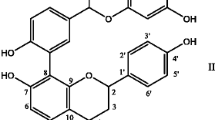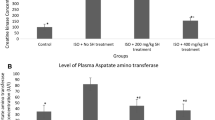Abstract
Schisandrin B (Sch B) is a hepato- and cardioprotective ingredient isolated from the fruit of Schisandra chinensis, a traditional Chinese herb clinically used to treat viral and chemical hepatitis. In order to investigate whether the induction of heat shock protein (Hsp)25 and Hsp70 expression plays a role in the cardioprotection afforded by Sch B pre-treatment against ischemia-reperfusion (I-R) injury, the time-course of myocardial Hsp25 and Hsp70 expression was examined in Sch B-pre-treated rats. Sch B pre-treatment (1.2 mmol/kg) produced time-dependent increases in Hsp25 and Hsp70 expression in rat hearts, with the maximum enhancement observable at 48 and 72 h post-dosing, respectively. Buthionine sulfoximine/phorone treatment, while abolishing the beneficial effect of Sch B on mitochondrial glutathione redox status, did not completely abrogate the cardioprotection against I-R injury. Heat shock treatment could increase myocardial Hsp25 and Hsp70 expression and protect against I-R injury under the present experimental conditions. The results indicate that the induction of Hsp25 and Hsp70 expression contributes at least partly to the cardioprotection afforded by Sch B pre-treatment against I-R injury (Mol Cell Biochem 266: 139–144, 2004)
Similar content being viewed by others
References
Hancke JL, Burgos RA, Ahumada F: Schisandra chinensis (Turcz.) Baill. Fitoterapia 70: 451–471, 1999
Ip SP, Poon MK, Wu SS, Che CT, Ng KH, Kong YC, Ko KM: Effect of schisandrin B on hepatic glutathione antioxidant system in mice: Protection against carbon tetrachloride toxicity. Planta Med 61: 398–401, 1995
Ip SP, Yiu HY, Ko KM: Schisandrin B protects against menadione-induced hepatotoxicity by enhancing DT-diaphorase activity. Mol Cell Biochem 208: 151–155, 2000
Ip SP, Ko KM: The crucial antioxidant action of schisandrin Bin protecting against carbon tetrachloride hepatotoxicity in mice: A comparative study with butylated hydroxytoluene. Biochem Pharmacol 52: 1687–1693, 1996
Ip SP, Che CT, Kong YC, Ko KM: Effects of schisandrin B pretreatment on tumor necrosis factor-alpha induced apoptosis and Hsp70 expression in mouse liver. Cell Stress Chaperones 6: 44–48, 2001
Salminen WF Jr, Voellmy R, Roberts SM: Protection against hepatotoxicity by a single dose of amphetamine: The potential role of heat shock protein induction. Toxicol Appl Pharmacol 147:247–258, 1997
Chong KY, Lai CC, Lille S, Chang C, Su CY: Stable overexpression of the constitutive form of heat shock protein 70 confers oxidative protection. J Mol Cell Cardiol 30: 599–608, 1998
Morimoto RI: Cells in stress: Transcriptional activation of heat shock genes. Science 259: 1409–1410, 1993
Welch WJ: Mammalian stress response: Cell physiology, structure/function of stress proteins, and implications for medicine and disease. Physiol Rev 72: 1063–1081, 1992
Jäättela M, Wissing D, Kokholm K, Kallunki T, Egeblad M: Hsp70 exerts its anti-apoptotic function downstream of caspase-3-like proteases. EMBO J 17: 6124–6134, 1998
Mehlen P, Preville X, Chareyron P, Briolay J, Klemenz R, Arrigo AP: Constitutive expression of human hsp27,Drosophila hsp27, or human alpha B-crystallin confers resistance to TNF-and oxidative stress-induced cytotoxicity in stably transfected murine L929 fibroblasts. J Immunol 154: 363–374, 1995
Merendino AM, Paul C, Vignola AM, Costa MA, Melis M, Chiappara G, Izzo V, Bousquet J, Arrigo AP: Heat shock protein-27 protects human bronchial epithelial cells against oxidative stress-mediated apoptosis: Possible implication in asthma. Cell Stress Chaperones 7: 269–280, 2002
Chiu PY, Tang MT, Mak DHF, Poon MKT, Ko KM: Hepatoprotective mechanism of Schisandrin B: Role of mitochondrial glutathione antioxidant status and heat shock proteins. Free Radic Biol Med 35: 368–380, 2003
Yim TK, Ko KM: Schisandrin B protects against myocardial ischemia-reperfusion injury by enhancing myocardial glutathione antioxidant status. Mol Cell Biochem 196: 151–156, 1999
Chiu PY, Ko KM: Time-dependent enhancement in mitochondrial glutathione antioxidant status and ATP generation capacity by schisandrin Bdecreases the susceptibilty of rat hearts to ischemia-reperfuison injury. Biofactors 19: 43–51, 2003
Siegers CP, Horn W, Younes M: Effect of phorone-induced glutathione depletion on the metabolism and hepatotoxicity of carbon tetrachloride and vinylidene chloride in rats. J Appl Toxicol 5: 352–356, 1985
Santori G, Domenicotti C, Bellocchio A, Pronzato MA, Marinari UM, Poli G, Cottalasso D: Effects of acute glutathione depletion induced by L-buthionine-(S,R)-sulfoximine on rat liver glucose-6-phosphatase activity. Res Commun Mol Pathol Pharmacol 98: 165–178, 1997
Qian YZ, Shipley JB, Levasseur JE, Kukreja RC: Dissociation of heat shock proteins expression with ischemic tolerance by whole body hypertermia in rat heart. J Mol Cell Cardiol 30: 1163–1172, 1998
Ko KM, Yiu HY: Schisandrin B modulates the ischemia-reperfusion induced changes in non-enzymatic antioxidant levels in isolated-perfused rat hearts. Mol Cell Biochem. 220: 141–147, 2002
Evans WH: Isolation and characterization of membranes and cell organelles. In: D Rickwood (ed). Preparative Centrifugation: A Practical Approach. Oxford University Press, New York, 1992, pp 233–270
Griffith OW: Determination of glutathione and glutathione disulfide using glutathione reductase and 2-vinylpyridine. Anal Biochem 106: 207–212, 1980
Pascoe GA, Olafsdottir K, Reed DJ: Vitamin E protection against chemical-induced cell injury. I. Maintenance of cellular protein thiols as a cytoprotective mechanism. Arch Biochem Biophys 256: 150–158, 1987
Fleming I: Cytochrome p450 and vascular homeostasis. Circ Res 89: 753–762, 2001
Hess ML, Manson NH: Molecular oxygen: Friend and foe. The role of the oxygen free radical system in the calcium paradox, the oxygen paradox and ischemia/reperfusion injury. J Mol Cell Cardiol 16: 969–985, 1984
Ambrosio G, Zweier JL, Flaherty JT: The relationship between oxygen radical generation and impairment of myocardial energy metabolism following post-ischemic reperfusion. J Mol Cell Cardiol 23: 1359–1374, 1991
Pagliaro P, Mancardi D, Rastaldo R, Penna C, Gattullo D, Miranda KM, Feelisch M, Wink DA, Paolocci N: Nitroxyl affords thiol-sensitive myocardial protective effects akin to early preconditioning. Free Radic Biol Med 34: 33–43, 2003
Mallouk Y, Vayssier-Taussat M, Bonventre JV, Polla BS: Heat shock protein 70 and ATP as partners in cell homeostasis. Int J Mol Med 4: 463–474, 1999
Iwaki K, Chi SH, Dillmann WH, Mestril R: Induction of HSP70 in cultured rat neonatal cardiomyocytes by hypoxia and metabolic stress. Circulation 87: 2023–2032, 1993
Author information
Authors and Affiliations
Rights and permissions
About this article
Cite this article
Chiu, P.Y., Ko, K.M. Schisandrin B protects myocardial ischemia-reperfusion injury partly by inducing Hsp25 and Hsp70 expression in rats. Mol Cell Biochem 266, 139–144 (2004). https://doi.org/10.1023/B:MCBI.0000049151.79238.30
Issue Date:
DOI: https://doi.org/10.1023/B:MCBI.0000049151.79238.30




